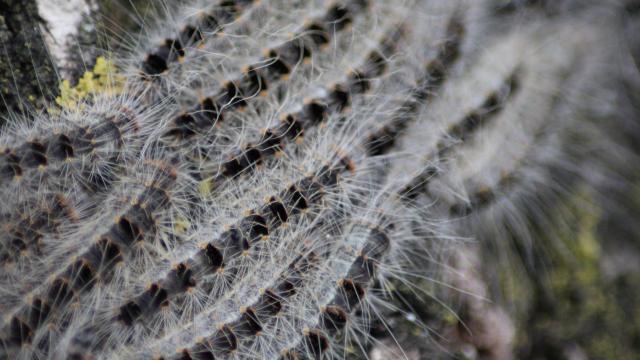Don’t underestimate the humble caterpillar. While it might not look all that dangerous compared to humans mainly worried about stings and bites, many varieties are covered in toxic spines, as residents of London were warned last weekend.
Thaumetopoea processionea, or the oak processionary moth, in its larval stage.Photo: Kleuske (Wikimedia Commons)
Per the New York Times, UK forestry officials are warning that oak processionary moth caterpillars have been sighted emerging from eggs in and near the city since mid-April. Each of their 62,000 hairs contain the protein thaumetopoein, which can cause allergic reactions up to “skin and eye irritation, difficulty breathing and even anaphylactic shock.”
The insects originate in southern Europe, but have had a presence in southern England since 2005, when live oaks from Europe were imported along with insect eggs. In addition to their potential danger to humans, they can strip oak trees of leaves, leaving them to die.
The BBC added that the Forestry Commission reported the biggest infestations were in Greater London, “stemming from Kingston upon Thames to Brent,” with additional infestations in “Bracknell Forest, Slough and Guildford.” The infestation could potentially spread throughout the country but is not yet suspected of doing so, per the Times.
It’s time to be vigilant! Oak Processionary Moth #opm spotted in parks across Bexley https://t.co/B4XJdPhA2u .
— RoyalForestrySociety (@royal_forestry) April 24, 2018
Forestry Commission workers began treating egg plaques where the caterpillars were seen this month and will leave signs indicating their presence, though a spokesman told the BBC, “The treatment programme is expected to continue until late May or early June. After that the caterpillars will be too large to be affected by our preferred treatment product.”
By July or August the caterpillars will have morphed into full-grown moths, but these only have a two-three day lifespan.
While touching the caterpillars themselves is obviously a bad idea, Dr. Robert Glatter of Manhattan’s Lenox Hill Hospital told the Times that the “true toxicity” of the insects arises from the hairs, which can be released into the air and remain toxic for up to five years.
At least one gardener told the BBC she had experienced “severe symptons” including rashes, nausea, and sores after coming into contact with the insects’ hairs. The news agency advises residents in the affected areas to watch out for caterpillars with “very long, white hairs which contrast markedly with other, shorter hairs,” and that form “arrow-headed processions” from tree to tree in which one caterpillar crawls ahead of others in broader rows.
